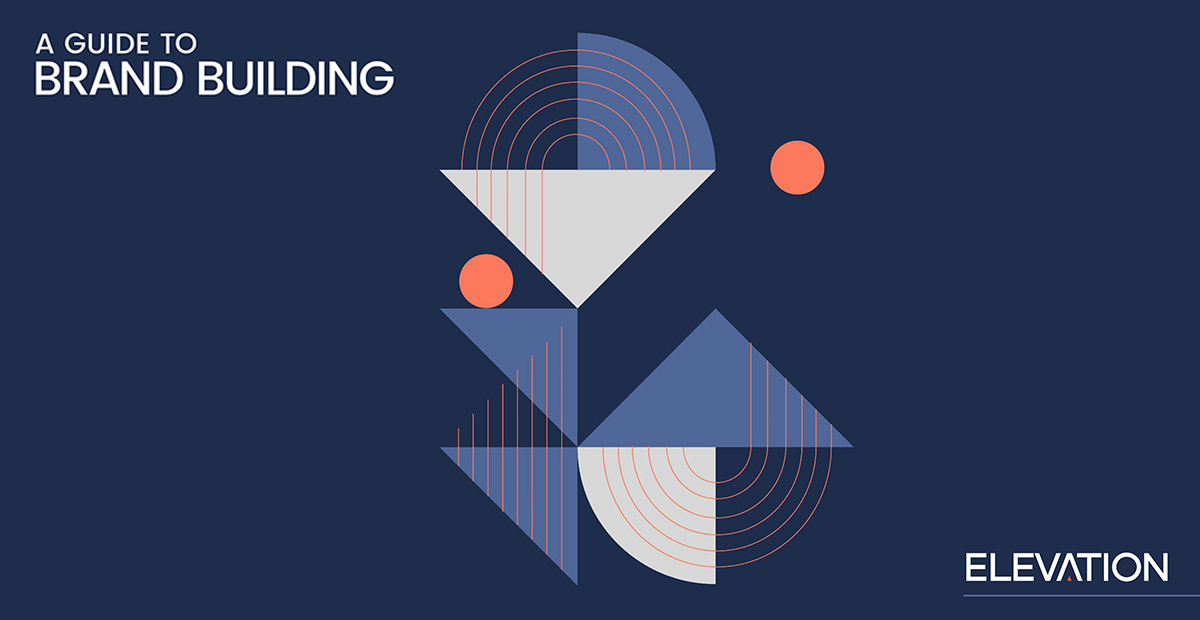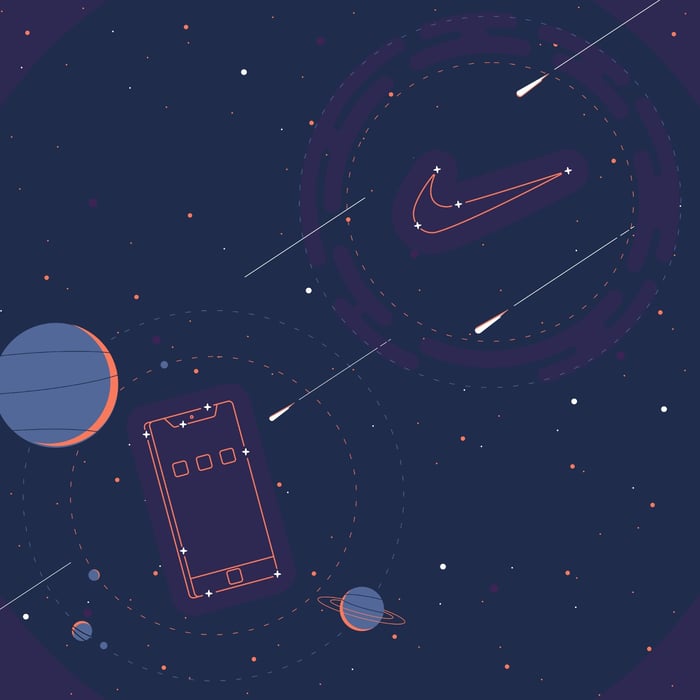
Elevation's Guide to Brand Building
Written by Elevation
How do you build a great brand?
It’s hard to overstate the value of great branding. Companies like Nike, Apple, and Coca-Cola are not only massively successful businesses, they are some of the most iconic and enduring brands in modern history. Just a glance at the distinctive silhouette of the iPhone or swooping script on a Coke bottle conveys a reassuring sense of quality.
It’s branding that inspires the type of customer loyalty and fervent fan bases that we all dream of. It’s branding that recruits the top talent, who will jump at the opportunity to be a part of the company’s mission.
You may believe that the key to building a brand like that is a memorable logo, on-trend fonts or colors, and a buzz-worthy marketing strategy.
That would be a mistake.
That’s not to say those are not very valuable aspects of branding. But building a brand is so much deeper than the style guide, visual identity, or even a quality product.
Our philosophy towards branding is holistic. Great branding is not only about how a company appears to the outside world. It’s about how it behaves and operates. It’s about how your company sees the world. Branding is a fundamental building block that should permeate product development, company culture, and every bit of messaging. If you nail your branding, your employees will buy into your vision. Your audience will evangelize for you. Your company will have a distinctive voice, point of view, and identity.
Branding gives people something to believe in. That’s why branding is so important.

In Elevation’s Guide to Brand Building, we will guide you through the world of branding. Literally. Let’s imagine a brand as a floating planet, in a vast universe of culture and commerce. We will build an entire planet of branding, from the elements that make up your foundational core to the orbiting satellites that boost your message.
On this page, you’ll be introduced to the main concepts that we take when we work with brands. In the coming months, we will be adding in-depth articles that explain each of these main pillars of brand building in greater detail.
Whether you’re starting from scratch or want to take your existing brand to the next level, here’s how to build a brand to its full potential.
It begins with a story...
Prologue: What makes great branding?
Branding is storytelling.
As humans, we are hardwired to tell stories. Our ancestors not only saw patterns in the stars, but they turned them into characters and passed along their stories so we could better navigate the world. Stories help us make sense of reality and connect with one another. At a primal level, we are story creatures.
Great brands tell great stories because stories resonate with us. They paint pictures in the sky of brighter futures. They make us laugh. Or they just “get” us. Through storytelling, these brands build immediate bonds with us, not unlike our heroes in the skies, connecting the dots to elicit emotion. Great brands tap into our inherent need to experience the world through stories. For more on how brands can utilize stories, read our post 6 Storytelling Strategies from a Screenwriter.

In return, we become brand ambassadors and share our experiences with others, who then share their experiences as well.
What is your brand’s story about? How do you tell that story to as many people as possible? And how can you create a brand story that resonates so that others will want to retell your story?
For those answers, let’s turn from the sky to the planet core.
Part 1: A brand’s foundational core
A planet is nothing without a strong core.
Neither is a brand.
A planet with no core is just space dust, aimlessly drifting until it’s pulled into another’s gravitational pull. This is what happens to brands that only focus on surface level aesthetics. They endlessly chase trends without establishing a solid identity.
The core is the foundation around which everything is built. It’s essential for growing a sustainable brand with a strong audience orbit. The stronger the core, the stronger the pull a brand will have.

A brand’s core isn’t a product, a name, or a logo. It’s a set of ideals that every employee and brand ambassador can embrace. A strong foundational core is woven into company culture and all brand decision making. It’s reflected in the people you hire, the messages you send, and the ways in which your brand affects the world.
Most importantly, it must be inspired and authentic.
What are the elements of a brand’s core?
- Mission
- Vision
- Purpose
- Values
- Point of View
Essentially, these make up a brand’s personality. Just like our own personalities, a brand is best served to be an honest representation of itself, so an audience can perceive who a brand truly is.
A good personality doesn’t have to be one thing in particular. Variety of personality is key for brands. Knowing your brand’s personality and promoting its best traits builds a relationship with your audience. Like in movies or stories in the stars, a brand can benefit from finding an archetype (not a stereotype) that helps to shape how the brand communicates and how brand decisions are made.
Are you unsure what your brand's personality is? Here are a couple of core exercises.
Core Exercise 1: Craft a strong mission statement
This is key for setting up brand success. It acts as a cornerstone for all decision making and as a rallying cry for brand stakeholders and audience members alike. A mission statement defines what a brand wants to achieve over the next 10, 20, or even 100 years. A great mission statement should outline the goals of the brand with a point of view, while defining how the brand will benefit society or its audience. Try to avoid specific product details or financial goals with the mission statement.
Core Exercise 2: Core quiz
Finish these three statements:
- We are…
- We can help with…
- We make the world/future better through…
For a deep dive into developing a strong brand core with more examples and exercises, be sure to read the next part of our guide: Building a Brand Core.
Further Reading
Part 2: A brand’s atmosphere - visual and verbal identity
For a planet to be inhabitable, it needs an inviting atmosphere with the right combination of elements. Too much of one element, and a planet’s atmosphere becomes poison.
And no one wants their brand to go toxic.
In our branding planet metaphor, what is the brand’s atmosphere? It’s an outward reflection of the core. Like Earth’s atmosphere, it’s what you see, hear, and experience. It’s where people first connect with a brand and begin sharing experiences.

A great brand atmosphere reflects and amplifies the brand’s personality. It should be unique to the brand and immediately recognizable. A brand’s atmosphere is comprised of two categories of elements: Visual Identity and Verbal Identity. As they build upon your brand’s core, these are more than just aesthetics. They create the experience and perception of your brand. They attract new customers and new talent to your world by conveying an atmosphere that says “This is the type of place you want to be.”
Just as our atmosphere is made up of the building blocks for life (oxygen, carbon dioxide, and the like), a brand’s atmosphere contains the building blocks for its outward identity as well as the elements that build brand-audience connections.
It starts with all the ways a brand is seen and heard.
Visual Identity
- Logo
- Colors
- Typography
- Photography
- Graphic Design
- Iconography
- Motion Behaviors
Verbal Identity
- Name
- Voice
- Tone
Utilized well across all forms of communication ranging from marketing campaigns to internal messaging, the voice of a brand is critical for developing trust and familiarity with an audience. This is often overlooked, but it’s crucial for creating a great brand atmosphere.
Atmosphere Exercise: Verbal balance
Take 10 minutes to write down all the words that best represent the voice of your brand. You can include simple concepts like “smart” or “professional,” and then dig a little deeper for more specifics like “neighborly” or “mischievous.”
Select 3-5 answers that everyone agrees are best fits.
Next, write the chosen identifiers in the middle column. In the left and right columns, write similar terms that are too weak and too strong to represent your brand’s voice.
If any of the edge terms fit better for your brand, move them to the center column and repeat the process.
By the end of the exercise, you’ll have a balanced set of terms to easily communicate through your brand’s voice.
For more in-depth information, check out Part 2 of Elevation’s Guide to Brand Building.
Further Reading
- Elevation's Guide to Brand Building Part 2: Creating an Inviting Brand Atmosphere
- The Strategy of Style
Part 3: A brand orbit - How to build an audience that will follow and engage with your brand
The goal of any brand is to build an engaged audience. People who not only follow you, but interact with you, share your message, and buy into your mission. We call this “Brand Orbit.”
Great brands don’t just push content, they pull in orbiters who choose to follow the path of the brand. This is the basis for loyalty and affinity towards a brand.
A steady stream of compelling content and audience interaction touch points will strengthen the pull and maintain orbit.
The core, atmosphere, and orbit all live in balance with each other. Just as an atmosphere with the wrong elements would make a planet with a good core uninhabitable, a brand orbit that is overloaded with junk could hide an amazing planet underneath. Staying true and consistent to your brand’s core across all interactions is key to not polluting the atmosphere.

To build a compelling orbit, brands must be multi-platform. They must be large and small, able to meet viral success as well as share in intimate moments. Potential orbiters are on every platform and every medium. Great brands explore each possible path to find their audience, across all of the cultural universe. Not all platforms are right for every brand, but the right platforms for the desired audience should be explored.
What are the elements that make up a strong Brand Orbit?
Content
- Branded Content
- Advertising/Marketing
- Social Media
- Educational Content
- Communications
- Thought Leadership
Activations
- Virtual Events
- Trade Shows
- Customized Interactions
Brands must reach as many orbiters as possible by finding the right platforms and using them in new and original ways.
Most brands have strategies for marketing, social media, and web presence. But, what are the specific touch points where your brand can stand out amongst the competition and convert new fans?
Orbit Exercise: Touchpoints
Spend 10 minutes writing down every touchpoint that your brand currently has with its audience. These can include things like specific social media sites, digital ads, live events, etc.
With a comprehensive list of current touch points in hand, take another 15 minutes to write down every possible unexplored touchpoint. Get creative here. Maybe it’s an ice cream truck like Uber employed to pass out free popsicles.
Review the new list of touch points, then decide on 3 that make the most sense for your brand to explore. Next, spend 15 minutes brainstorming ways to activate these touch points. This is a great way to generate new ideas that will strengthen your audience's orbit.
Find out more examples of ingenious content strategies in Part 3 of this guide.
Further Reading
- Elevation’s Guide To Brand Building Part 3: Brand Orbit Through Strategic Content
- How to Translate Your Brand's Story Into Content
Conclusion: Branding isn’t marketing
Great brands need great marketing.
But great marketing does not make a great brand.
Marketing is topical. Marketing is temporary. Branding is foundational. Branding is lasting.
It’s important to know the difference. The success of a brand can be defined by the tendency of orbiters to stay near. Great brands inspire us to float.
To exist without tension.
To enjoy the night sky and wonder.

And organic, authentic experiences like that …well, we never keep those to ourselves.
We share them. We connect more dots.
We build an even bigger story. Together.
Topics: creative strategy, rebrand/refresh development, brands
